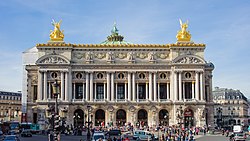
Back قصر غارنييه Arabic اوبرا باريس ARZ Ópera Garnier AST Qarnye Sarayı Azerbaijani Париж милли операһы Bashkir Опера Гарнье Byelorussian Пале Гарние Bulgarian পালে গার্নিয়ে Bengali/Bangla སྒར་ཉེའི་ཟློས་གར་ཁང་། Tibetan Òpera Garnier Catalan
Opéra Garnier | |
 View of the principal façade of the Palais Garnier from the Place de l'Opéra | |
 | |
| Former names | Nouvel Opéra de Paris |
|---|---|
| Address | Place de l'Opéra 75009 Paris France |
| Coordinates | 48°52′19″N 2°19′54″E / 48.87194°N 2.33167°E |
| Public transit | |
| Type | Opera house |
| Capacity | 1,979 |
| Construction | |
| Broke ground | August 1861[1] |
| Opened | 5 January 1875 |
| Construction cost | 36,010,571.04 francs (as of 20 November 1875)[2] |
| Architect | Charles Garnier |
| Tenants | |
| Paris National Opera | |
| Website | |
| operadeparis.fr | |
| Designated | 16 October 1923 |
| Reference no. | PA00089004 |
The Palais Garnier (French: [palɛ ɡaʁnje] ⓘ, Garnier Palace), also known as the Opéra Garnier (French: [ɔpeʁa ɡaʁnje] ⓘ, Garnier Opera), is a historic 1,979-seat[3] opera house at the Place de l'Opéra in the 9th arrondissement of Paris, France. It was built for the Paris Opera from 1861 to 1875 at the behest of Emperor Napoleon III.[4] Initially referred to as le nouvel Opéra de Paris (the new Paris Opera), it soon became known as the Palais Garnier,[5] "in acknowledgment of its extraordinary opulence"[6] and the architect Charles Garnier's plans and designs, which are representative of the Napoleon III style. It was the primary theatre of the Paris Opera and its associated Paris Opera Ballet until 1989, when a new opera house, the Opéra Bastille, opened at the Place de la Bastille.[7] The company now uses the Palais Garnier mainly for ballet. The theatre has been a monument historique of France since 1923.
The Palais Garnier has been called "probably the most famous opera house in the world, a symbol of Paris like Notre Dame Cathedral, the Louvre, or the Sacré Coeur Basilica".[8] This is at least partly due to its use as the setting for Gaston Leroux's 1910 novel The Phantom of the Opera and, especially, the novel's subsequent adaptations in films and the popular 1986 musical.[8] Another contributing factor is that among the buildings constructed in Paris during the Second Empire, besides being the most expensive,[9] it has been described as the only one that is "unquestionably a masterpiece of the first rank".[10]
The Palais Garnier also houses the Bibliothèque-Musée de l'Opéra de Paris (Paris Opera Library-Museum), which is managed by the Bibliothèque Nationale de France[11] and is included in unaccompanied tours of the Palais Garnier.[12]
- ^ Mead 1991, p. 146. Haussmann reported on 14 August 1871 that the site had been cleared and surveyed. A temporary building for the Opéra Agence was erected in August, and excavation was begun on the 27th.
- ^ Mead 1991, p. 197. According to this source, more work was done after this date, and some parts of the building were never completed. The figure does not include the costs of acquiring and clearing the land, which was the responsibility of Haussmann's Service d'Architecture and probably exceeded 15 million francs (Mead 1991, pp. 140, 146).
- ^ Beauvert 1998, p. 102.
- ^ Hanser 2008, pp. 172–173.
- ^ "Courrier de Paris", Le Monde illustré 22 January 1878, p. 50.
- ^ Beauvert 1996, p. 108.
- ^ Ayers 2006, p. 188.
- ^ a b Hanser 2008, pp. 172–179.
- ^ Simeone 2000, p. 177.
- ^ Watkin 1996, pp. 391–392.
- ^ "Bibliothèque-Musée de l'Opéra" (in French) at the BnF website. Retrieved 3 August 2011.
- ^ "Palais Garnier" Archived 18 October 2011 at the Wayback Machine at the Paris Opera website. Retrieved 3 August 2011.